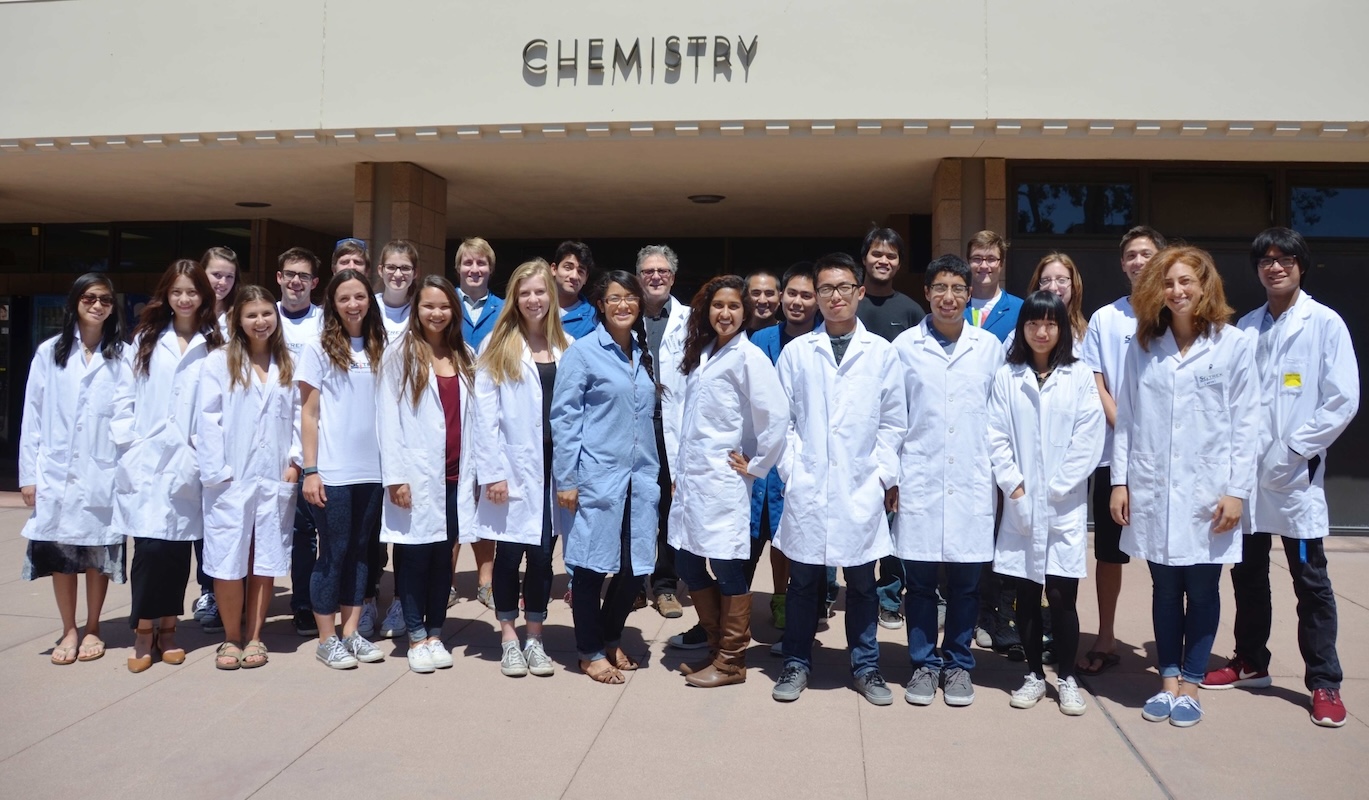SciTrek Connects Science Undergrads with School Kids
UC Santa Barbara Program Receives $1 Million in Federal Funding

This article was originally published in UCSB’s ‘The Current‘.
Science is more than a body of knowledge,” astronomer and educator Carl Sagan once said. “It is a way of thinking; a way of skeptically interrogating the universe.” And yet, throughout their K-12 education, many children encounter science only as a set of facts and procedures.
This approach leaves a lasting impression. “I see my college students really struggling with experimental design,” said Darby Feldwinn, a chemistry professor at UC Santa Barbara. “They can give me facts, but they struggle with understanding how to design an experiment.”
“The question is, how young do you have to start in order to teach this inquisitive, problem-solving mindset?”
Reaching students earlier
In 2010, Feldwinn and biochemistry professor Norbert Reich had an idea: Get enthusiastic undergraduate volunteers to lead hands-on learning experiences in K-12 classrooms. Now entering its 14th year, the SciTrek outreach program is set to expand its scope and offerings. Spearheaded by U.S. Representative Salud Carbajal, a nearly $1 million grant directly from Congress will enable the program to offer undergraduate fellowships and leadership training, as well as pilot virtual offerings.
SciTrek focuses on the most resource-intensive part of science education: designing and carrying out experiments. Each “Module” involves five to eight days of experiments on a particular topic, such as sound waves or cellular respiration. A teacher or SciTrek staff member leads the module, while undergraduate mentors work directly with small groups of students in K-12 classrooms.
“They do an experiment; they collect their own data; they come up with their own ideas. They make mistakes; they fail; they do it again,” Reich said. “At the end they come up with a poster and they argue about it, just like science in a research setting.” While incredibly effective, this experiential approach to education can be difficult to pull off, especially in elementary schools.

“But when the students have agency over what they get to do in the experiment, then that motivates them differently and helps them understand that science is a process, and a way of thinking, and not a procedure,” explained Vanessa Woods, a professor in the Department of Psychological & Brain Sciences who’s conducted research on the program’s efficacy.
“Developing scientific modules for K-12 students is a crucial aspect of fostering a deeper understanding and appreciation of science from a young age,” added Gulistan Tansik, the program’s co-manager. “These modules are designed to be interactive and hands-on, providing students with the opportunity to experience the wonders of science firsthand. By engaging in these activities, students are encouraged to ask questions, explore concepts and develop a deeper curiosity about the world around them.”
In addition to developing scientific modules aligned with the K-12 curriculum, SciTrek brings students and teachers together at events designed to strengthen communication and collaboration, Tansik said. These events create a dynamic learning environment where students and teachers can exchange ideas, fostering a supportive and inspiring educational community.
Measuring impact
Professor Woods is keen on evaluating how SciTrek affects all of the groups involved: students, teachers and undergraduate mentors. Results have shown a clear improvement in elementary school students’ understanding of how science works, both from student assessments and teacher reports. The program also improved secondary students’ critical thinking and problem-solving skills. Teachers appreciated how the undergraduate mentors served as role models to their students, a key benefit of participating in the program.
“And we’re not just providing the programs for the students,” Feldwinn said. “We’re providing teacher professional development as well.” Indeed, 81% of elementary school teachers reported increased confidence in teaching science after participating in SciTrek. Many began to apply the techniques they learned in the program in other subjects as well, and secondary teachers reported that it helped them polish their skills engaging students in scientific discourse.
Just as importantly, Woods’ research showed that undergraduate mentors held more positive beliefs about themselves as scientists after participating in the program. Two thirds of secondary students reported that the SciTrek mentors changed their ideas of who could be a scientist, and undergraduate mentors from backgrounds less represented in STEM were more likely to view themselves as a role model for the K-12 students.

The team sees a natural connection between STEM interest in school children and in undergraduates. “If you try to convince an 18-year-old woman that she should go into physics when she’s already decided she doesn’t want to, it is not very effective,” Woods said.
Woods and Feldwinn began discussing how SciTrek’s work with K-12 students could be an interesting way to approach this problem. “What if we can maintain science interest and model scientific thinking in ways that keep students engaged and maintain their interest in STEM majors and careers?” she added. “SciTrek could be a way to do this.” SciTrek has garnered some success maintaining student interest in science against the national trends they see of declining interest in science starting in middle school.
Developing role models
Each year, up to 300 undergraduates work with as many as 1,500 kids at 32 schools in three districts in the Santa Barbara and Goleta areas. “Having undergraduates expose children to science in the classroom is incredibly compelling to kids and teachers,” explained Charlotte Zeamer, the program’s senior manager, “because undergrads are much nearer in age and life experience to these kids.”
The SciTrek team has made a priority of matching mentors with the students they serve. For instance, some schools have many multilingual learners. The team tries to place volunteers in those schools who speak Spanish, so students can engage with modules in the language they’re most comfortable in. The Congressional allocation will help fund fellowships for Hispanic students to increase the number of undergraduate volunteers fluent in Spanish.
SciTrek has already proven itself a boon to UCSB’s undergraduates and faculty, who’ve integrated the initiative into courses in the Department of Education, the Department of Chemistry and Biochemistry and as an Interdisciplinary Studies class. The new funding will enable the team to incorporate leadership training in fall 2024 for interested undergraduates who have worked with SciTrek Secondary. The training will be woven into the students’ curriculum of pedagogy and program content, and will teach skills like innovation, conflict resolution and time and energy management.
Sharing success
The SciTrek team wants to spread their model so other communities can create well supported, well funded networks of educational resources. Prior funding from the National Institutes of Health, the Department of Defense, and the Karisma Foundation have already allowed the program to expand considerably. “We all want SciTrek to be at every interested university and school around the country,” Zeamer said. Their 2024 annual report will focus on a tool kit for expanding the program to other universities.
Several colleges and universities have already joined UCSB’s initiative. Cal Poly San Luis Obispo launched a SciTrek program in 2022, as did CSU Channel Islands and Santa Barbara City College in 2021. After 14 years, the core team has dialed in which features are essential to the program and which aspects can be customized based on the university and the community it serves. So, while SciTrek varies between campuses based on the students involved, the core concept and modules remain consistent. Reich is helping Oregon Health Science University launch a new program this fall.
UCSB has continued to provide SciTrek’s curriculum and model, and it has requirements for partnering with other institutions to ensure their programs meet the standards developed here. Each institution has its own coordinators to manage the volunteers, update the curricula and liaise with teachers.
But not every school has a college or university nearby, so the group also wants to learn whether this model can be successful virtually. Part of the $1 million in Congressional funding will support a pilot program in Lompoc testing the feasibility of this idea. New math and astronomy modules could be a good fit for a virtual approach.
We’ve all heard stories of great teachers inspiring their students, of mentors who spark a journey of discovery in history, physics or literature. The challenge is that fantastic teachers are uncommon, said Reich, and the inspiration they provide isn’t scalable. This is precisely where Felwinn, Reich, Woods, Tansik and Zeamer hope SciTrek can shine.
“I’m not necessarily interested in making little scientists out of students,” Reich said. “I’m interested in improving their understanding of how to think deliberately, critically, about problem solving.”
Premier Events
Fri, Nov 22
11:00 AM
Santa Barbara
Santa Barbara Antique & Vintage Show & Sale
Fri, Nov 22
6:00 PM
Santa Barbara
Introduction to Crochet Workshop
Fri, Nov 22
7:30 PM
Carpinteria
Rod Stewart VS. Rolling Stones Tribute Show
Fri, Nov 22
9:00 PM
Santa Barbara
Numbskull Presents: Jakob’s Castle
Sat, Nov 23
11:00 AM
Santa Barbara
Santa Barbara Antique & Vintage Show & Sale
Sat, Nov 23
12:00 PM
Santa Barbara
Fall 2024 Healing Arts Faire
Sat, Nov 23
7:30 PM
Santa Barbara
SBCC Theatre Arts Department presents “Mrs. Bob Cratchit’s Wild Christmas Binge”
Sun, Nov 24
11:00 AM
Santa Barbara
Santa Barbara Antique & Vintage Show & Sale
Sun, Nov 24
6:00 PM
Santa Barbara
¡Viva el Arte de Santa Bárbara! Mariachi Garibaldi de Jaime Cuellar
Sun, Dec 01
5:00 PM
Santa Barbara
Paseo Nuevo Tree Lighting Ceremony
Fri, Nov 22 11:00 AM
Santa Barbara
Santa Barbara Antique & Vintage Show & Sale
Fri, Nov 22 6:00 PM
Santa Barbara
Introduction to Crochet Workshop
Fri, Nov 22 7:30 PM
Carpinteria
Rod Stewart VS. Rolling Stones Tribute Show
Fri, Nov 22 9:00 PM
Santa Barbara
Numbskull Presents: Jakob’s Castle
Sat, Nov 23 11:00 AM
Santa Barbara
Santa Barbara Antique & Vintage Show & Sale
Sat, Nov 23 12:00 PM
Santa Barbara
Fall 2024 Healing Arts Faire
Sat, Nov 23 7:30 PM
Santa Barbara
SBCC Theatre Arts Department presents “Mrs. Bob Cratchit’s Wild Christmas Binge”
Sun, Nov 24 11:00 AM
Santa Barbara
Santa Barbara Antique & Vintage Show & Sale
Sun, Nov 24 6:00 PM
Santa Barbara
¡Viva el Arte de Santa Bárbara! Mariachi Garibaldi de Jaime Cuellar
Sun, Dec 01 5:00 PM
Santa Barbara




















You must be logged in to post a comment.